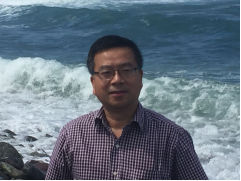报告题目:Propagation Phenomena for a Two-Species Lotka-Volterra Strong Competition System with Nonlocal Dispersal
报 告 人:Professor Xiaoqiang Zhao, Memorial University of Newfoundland, Canada
https://www.math.mun.ca/~zhao/
照片:

邀请人:吴事良 白振国
报告时间:2020年6月24日(周三) 19:30-20:30
腾讯会议ID: 593 672 943
点击链接入会:https://meeting.tencent.com/s/44Wuqiy6UzzS
报告人简介:赵晓强教授1983年和1986年分别在西北大学数学系获学士和硕士学位,1990年1月在中国科学院应用数学研究所获博士学位,师从我国运动稳定性理论先驱秦元勋先生。1990年至1998在中科院应用数学研究所先后任助理研究员、副研究员、研究员。1997年至2005年先后任美国Arizona州立大学访问教授、加拿大纽芬兰纪念大学助理教授、副教授,从2005年9月至今任纽芬兰纪念大学教授。2008年9月获该校University Research Professorship荣誉。
赵晓强教授是国际应用动力系统和生物数学领域中非常活跃的学者之一。他关于单调动力学、一致持久性、行波解和渐进传播速度、基本再生数的理论及应用方面的一系列工作已经成为了相关研究方向的经典文献。 迄今为止,赵晓强教授在“Comm. Pure Appl. Math.、 J. Eur. Math. Soc.、 J. Reine Angew. Math.、 J. Math. Pures Appl.、Trans. Amer. Math. Soc.、SIAM J. Math. Anal.、 SIAM J. Appl. Math.、J. Nonlinear Science、 J. Functional Anal.、 J. Differential Equations、 J. Math. Biology、Bull. Math. Biology”等国际著名期刊上发表学术论文100余篇,并著有 “Dynamical Systems in Population Biology(Springer-Verlag)”。此外,赵教授目前担任三个国际动力系统和应用分析期刊的编委。
报告摘要:We consider the propagation phenomena for a two-species Lotka-Volterra strong competition system with nonlocal dispersal. We first establish the existence of bistable traveling waves by appealing to the theory of monotone semiflows. Then we use a dynamical systems approach to prove that such a bistable traveling wave is asymptotically stable and unique modulo translation. Finally, we study the spreading properties of solutions for a class of initial conditions by the comparison arguments and the methods of super- and subsolutions. It is shown that for initial conditions where both species $u$ and $v$ are initially absent from the right half-line $x > 0$, and the species $v$ dominates the species $u$ around $x=-\infty$ initially, if $v$ spreads in absence of $u$ slower than $u$ in absence of $v$, then solutions of the initial value problem will approach a propagating terrace, which connects the unstable state $(0,0)$ to the stable state $(1, 0)$, and then the stable state $(1,0)$ to the other stable state $(0,1)$. This talk is based on a joint work with Dr. Guo-Bao Zhang.